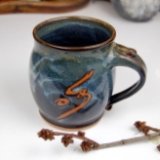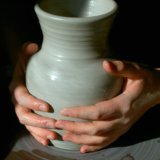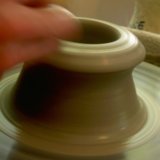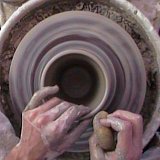How to Make Homemade Clay
From a Powdered Mix
The best way to save money on
ceramics supplies
is to learn how to make homemade clay. A premixed recipe for homemade clay is cheaper to buy and to ship than wet clay.
Click to learn
how to choose the right pottery clay.
You can purchase premixed powdered clay in the bag from most
ceramic art supplies stores.
Most clay is available in dry or moist forms. The cost for a 50lb. bag is the same whether it's dry or moist. So if you buy the moist clay, you're paying the shipping on a lot of water. If you're looking to save a bunch of money, buy a 50lb. bag of dry clay and mix it yourself (read more below)!
Let's look at how to make processed powdered clay with a mixer or without one.
Using a Mixer
If you have access to a clay mixer it will do most of the hard work for you. A clay mixer is a powerful machine that can stir large amounts of thick clay.
Simply add the powdered clay recipe, add water and mix. You can customize how wet your ceramic clay is by adding more or less water.
The clay can be used immediately after mixing or you can let it age for a day or up to a year or more. Aging is said to increase the plasticity of the clay, giving it better workability.
Tip: Additionally, running the clay through a
pug mill
will mix it further and press the air bubbles out of it. A pug mill is time saving, but not necessary.
Tip: Always wedge your homemade clay thoroughly before throwing your
clay pot projects
with it.
Wedging your pottery clay
is especially important if you don't use a pug mill.
Using Ingenuity
When I was in college, our studio had a pug mill, but no mixer. Actually, I was the mixer.
Whenever a pot failed, we would throw it in a 55 gallon bucket along with our leftover slip and some powdered clay. Periodically, I would stir the buckets and add or remove water to keep it thick and goopy.
When a bucket filled up I would load the clay into the pug mill with some additional clay powder. A wet version of the final product would come out.
I would then run it through a second, and sometimes, a third time to get the moisture content just right. Finally, I would wrap it all up in plastic bags and store it until the next student was ready to use it.
Looking back, I realize that it was an odd system for mixing clay. Someone had invented that system based on the equipment they had available.
At the time, I didn't know any different, and the system worked, so we continued doing it. For me, it just goes to show how important creativity and ingenuity are when it comes to
making pottery.
How to Make Homemade Clay
Without a Mixer
If you don't have a clay mixer or pug mill you can still save a lot of grunt work by first creating a slurry with the powdered clay. All you need is a bucket and a power drill with a mixer attachment. This is a much smaller, less powerful way to mix, but it's still way easier than doing it by hand.
Tip: I can't emphasize enough how great power drills are! You can get inexpensive attachments for them that make an amazing clay or
glaze mixer.
If you've ever tried to stir a big bucket of glaze where the minerals have settled to the bottom, you know what a life saver a drill can be. For a small investment, it will literally save your wrists, your energy and a ton of precious time that could be used creating.
Fill the bucket half way with water. Add powdered clay little by little while mixing until it is creamy like cake frosting or pancake batter. Mmmm, that makes me hungry.
Finally, pour the mixture out. Allow it time to thicken to a nice throwable state. Wedge it thoroughly before throwing.
Drying Tips
When learning how to make homemade clay, there are a couple of ways you can dry your clay effectively. You can pour it onto a plaster slab or drying table and let it air out. Or you can wrap it up in fabric, like canvas or an old sheet until it thickens.
Now that you know how to make homemade clay, you can throw more pots and save more money. Be sure to wear a proper dust mask when working with powdered clay, and wedge your clay before throwing.
Thanks for visiting, and Happy Potting.
>> Great book for understanding clay >>
It will help you choosing the right clay and ingredients for your clay.
Return From How to Make Homemade Clay
To How to Make Clay
Return From How to Make Homemade Clay
To Pottery on the Wheel Home
Enjoy this page? Please pay it forward. Here's how...
Would you prefer to share this page with others by linking to it?
- Click on the HTML link code below.
- Copy and paste it, adding a note of your own, into your blog, a Web page, forums, a blog comment,
your Facebook account, or anywhere that someone would find this page valuable.










